A few weeks back, Rick Karban and I headed to the east side of the Sierras and the White Mountains to look for some
Abronia and
Nicotiana species for continuing projects. I also took a wish list of species (with herbarium GPS coordinates) that seemed worth checking out. We were able to easily find
Abronia nana (not really sand-catching),
Abronia turbinata (somewhat sand-catching),
Nicotiana attenuata (bug-catching), and
Alliciella monoensis (sand-catching). I also had a record of
Aquilegia shockleyi, the desert columbine. After spending so many hours over a few years looking at
eximia (
here,
here), I've spent more time looking at other columbines. The sierra species,
formosa, is fairly boring from an insect-plant perspective, being nonsticky, largely devoid of predatory bugs and often covered in aphids.
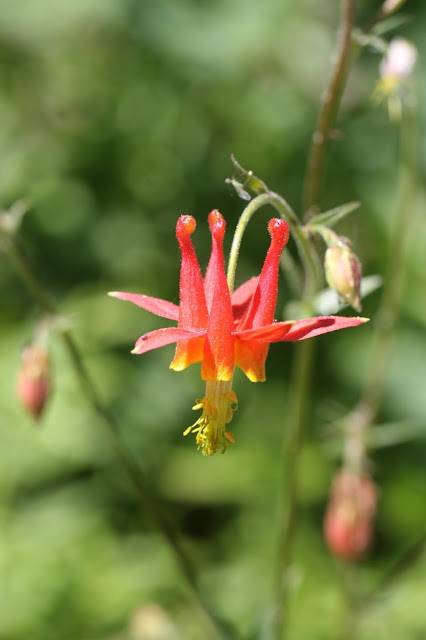 |
| This Aquilegia formosa was growing along Mormon Emigrant Trail (El Dorado county), seen on the way to the east side. Compared to my eximia, it has tiny flowers (probably 2/3 the size of eximia). With only anecdotal evidence to support this, I suspect that this is because Calliope Hummingbirds, the smallest one around, are a common visitor (though others are, too) and would be unlikely to successfully access the nectar in a much bigger flower. |
 |
| Aphid exuviae on a bud of A. formosa. |
The Jepson said that
shockleyi hybridizes with
formosa in desert mountains, so I was expecting it to be fairly similar - nonsticky and not that interesting from my plant-insect perspective. Fortunately, I was wrong.
 |
| Aquilegia shockleyi, White Mountains, CA. |
In a really pretty little desert oasis, we found a nice population of
shockleyi growing in a flowing spring with my favorite thistle,
Cirsium douglasii, an associate of
A. eximia at my field site. This species is every bit as sticky as
eximia, every stem had dozens to hundreds of entrapped insects.
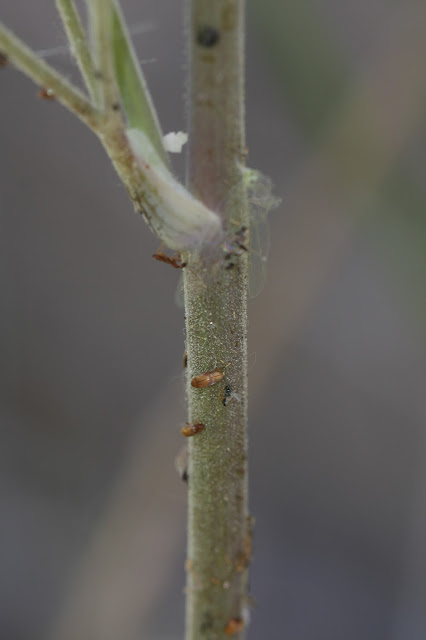 |
| A typical shockleyi stem - dead beetles, flies, wasps - tasty morsels for the right predator! |
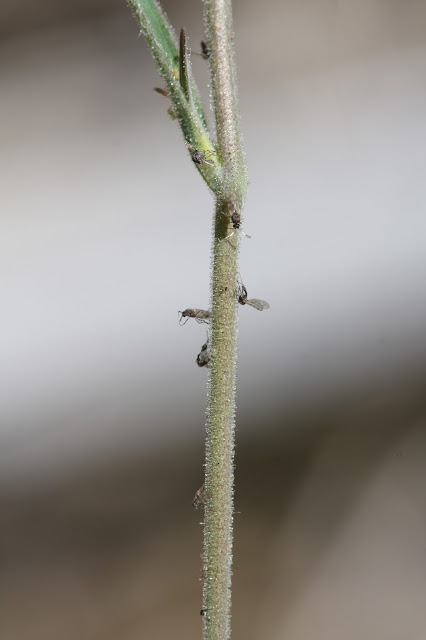 |
| Another, for good measure. |
Of course, my first thought was - is a carrion-mediated defense system happening in this species, too? That requires that there are scavenging predators and herbivores that the predators can eat (often they eat just the herbivore eggs). Sure enough, in just a few stems, I quickly found both.
The herbivore was, predictably, Heliothis phloxiphaga - a really common and destructive caterpillar that is common on most glandular plants in California and is multivoltine (has several generations per year). It is extremely bad for plants as, unlike many caterpillars, it largely eschews leaves in favor of buds, flowers and fruit (it is part of the aptly named group, the budworms). This is the same species that eats eximia and is controlled by the sticky plant predators at McLaughlin, where they consume its eggs and small caterpillars.
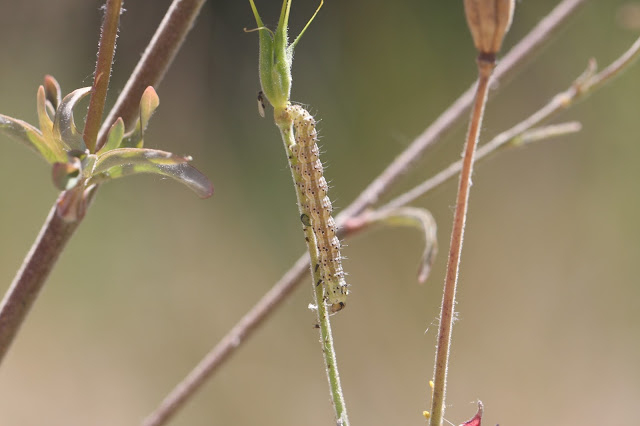 |
| A late-instar caterpillar on shockleyi. They have no trouble at all moving on the sticky stems of any plant, though I don't know exactly how they do it. |
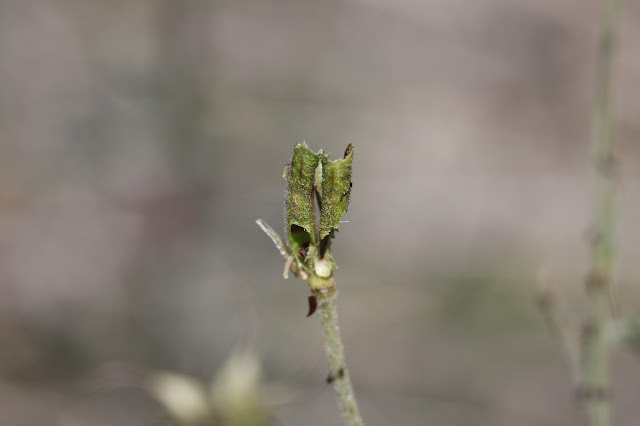 |
| Typical Heliothis damage to a shockleyi fruit. It has consumed 3 of the carpels (the seed pods) completely and consumed all the immature seeds from the two remaining ones seen in the picture. |
Predators were present as well. They were not in abundance, but were around. The most common was Hoplinus eschinatus - usually the most common on eximia, as well as tarweeds, sticky Mimulus, sticky tobaccos, etc. They are great egg predators and are just great insects in general. I got only crummy pictures that are not worth sharing here. The other interesting predator present was Oecantha - tree crickets. I only saw two really tiny nymphs (pictured below), but they are also on eximia in low numbers. Unlike most Orthoptera (the grasshopper/cricket/katydid order), they are really omnivorous, feeding on dead insects, live insects, as well as the plant in small quantities. On tarweeds, especially Madia, where they are common, they have benefits and costs the plants - they are predators and remove some herbivores, but they also chew leaves and oviposit into the stem, leaving big scars. I've never seen these scars or any evidence of them chewing on columbines (which are notoriously toxic to many animals), so I suspect that is less of a problem, but I really don't know. I've only seen them three or four times in three years of working on eximia, so I'd bet they are too rare to really have a huge impact - and these two were the only which I saw on shockleyi.
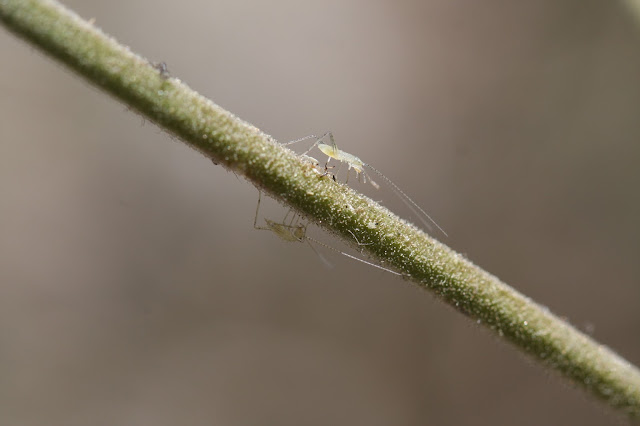 |
| Two tree cricket nymphs. |
There was one interesting contrast to the eximia system. A seed bug of some sort (I didn't collect it) was present and feeding on the seeds. I've noticed occasional clutches of eggs on eximia, but the nymphs either disperse or perish in the stickiness; I've never seen one actively feeding. This bug moved with seeming ease and was common. I'd bet that Hoplinus and other sticky plant predators would be effective at controlling it; the egg masses are present on the plant and the nymphs likely stick around on the same plant (somewhat important for the carrion-provisioning system to work).
 |
| Unknown bug feeding on shockleyi seeds in a ripe fruit. |
 |
| Just hatched nymphs of the unknown bug on a ripe shockleyi fruit. |
In conclusion, this was a really cool plant, and it is a strong, strong, candidate for the carrion-provisioning system which I described in eximia. Someone should study it. A simple carrion-removal experiment, checked weekly through the growing season would be an easy project (for an undergrad, perhaps?) and would give us new insights (how do these sticky plant predators control seed bugs?) and would be really fun. There is nothing as much fun as being in a wet place in the desert or coast range, with hummingbirds visiting the columbines around you and other birds, mammals and insects abundant in the little watery oasis.
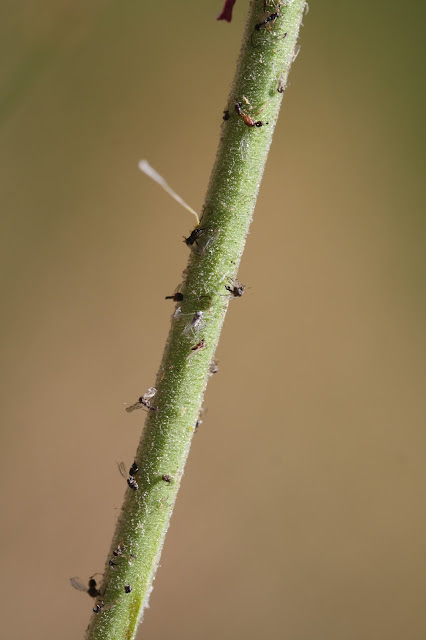 |
| Another picture of dead stuff on shockleyi stems. Please study it. |
